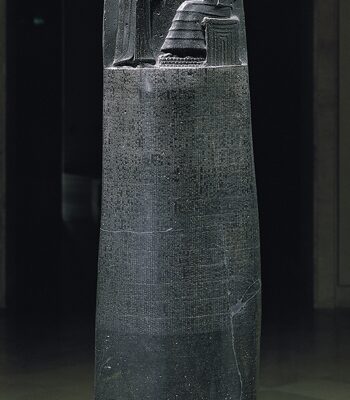When the Greek historian Herodotus visited Babylon in the 5th century BCE, he made the notable observation that there were no doctors in the city. He noted that the sick were brought to the marketplace to seek advice from those who had suffered from similar illnesses. This story suggests that one should not fully trust the accounts of travelers. As we can see, Mesopotamia had a complex medical tradition. Both empirical and magical methods of treatment had ancient roots, but gradually, the advantage clearly leaned towards the sorcerers. Evidence of various types of healers practicing in the region can be found in the most comprehensive legal code of Babylon, the Code of Hammurabi. Today, Hammurabi (reigning from 1792-1750 BCE) is the most famous king of Babylon, noted more for the code that bears his name than for his military and political victories. The code contains many provisions concerning illness, adoption, prostitution, nursing, maternity, miscarriage, and the malpractice of physicians and veterinarians. The laws particularly relevant to the history of medicine are those related to surgeons, veterinarians, midwives, and wet nurses, which follow the laws dealing with assault cases. Nine sections are devoted to regulating medical fees and clarifying the relationship between the condition of the patient and the appropriate payment or penalty. The severe punishments outlined necessitated that physicians exercise great caution in accepting patients and avoid nearly hopeless or litigious cases. The laws also reflect a clear distinction between internal medicine and surgery. Physicians dealing with what we now call “internal medicine” were members of the priestly class, and their professional activities were not subject to the criminal laws related to assault and malpractice.
Because internal disorders were believed to be caused by supernatural forces, those afflicted with such illnesses were thought to have offended the gods. External wounds, on the other hand, were attributed to direct human error or aggression. Therefore, those who wielded the “bronze knife” were held accountable to earthly authorities. The fees for surgical procedures and the penalties for surgical errors were quite high. If a doctor performed a major surgery and saved the life or restored the sight of a noble, the fee was 10 shekels of silver. This fee was halved for a commoner, and only 2 shekels for a slave. However, if the doctor performed surgery and caused the death of the noble or damaged his sight, the doctor would have his hand cut off. If the doctor caused the death of a slave, he would only need to compensate by providing another slave. If the doctor damaged the sight of a slave, he would need to compensate the owner with half the value of the slave in silver.
Women worked as midwives, surgeons, and even court physicians in Mesopotamia, but the Code of Hammurabi does not mention female doctors. However, the laws do refer to women serving as wet nurses (women who breastfeed infants that are not their own). If a nobleman entrusted his son to a wet nurse and the child died, the nurse would have her breasts cut off if she took in another child without informing the child’s parents. Naturally, this severe punishment ensured that the woman would never have the opportunity to repeat the offense.
The Code of Hammurabi is the oldest written code of law ever discovered and is considered one of the most significant achievements in the history of ancient civilization. The value of this code continues to be a subject of extensive research, study, and inheritance by many scholars. The code was meticulously crafted to regulate and vividly reflect the economic, political, and socio-cultural activities of the Babylonian kingdom. It holds immense value not only for legal research but also as a rich and invaluable historical source for studying the culture of ancient Babylon and Mesopotamia.

